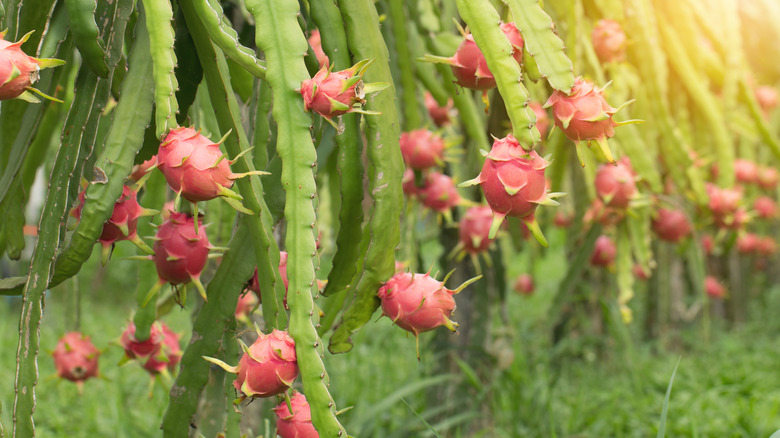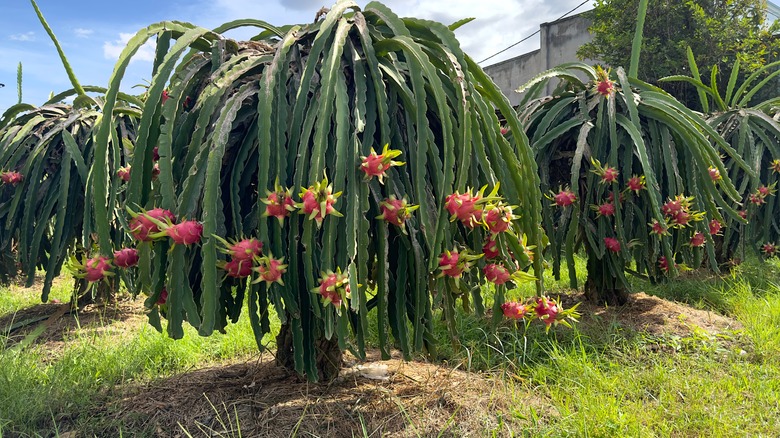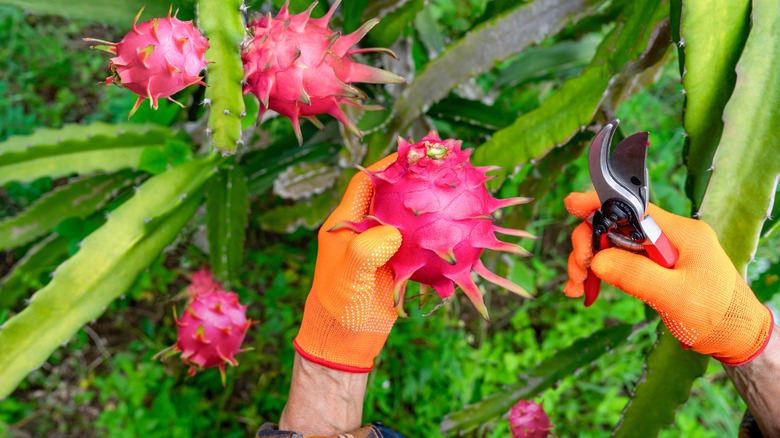Juicy Tips For Growing Delicious Dragon Fruit In Your Garden
A low-maintenance plant with edible fruit and gorgeous flowers is a gardener's dream come true. So say hello to the dragon fruit. This tropical cactus hails from Central and South America. Dragon fruit can be invasive in central and south Florida, but it thrives everywhere else in USDA zones 10 through 12. Ideally, once the cactus receives ample sunlight, nutrients, space, and support, you'll have a stunning ornamental plant with delicious fruit.
There are three main varieties of dragon fruit. Hylocereus undatus is most common, known for its pink skin and white flesh. Hylocereus costaricensis (pink skin and flesh) and Hylocereus megalanthus (yellow skin and white flesh) are less common, but all three thrive in similar growing conditions. There are only a few mistakes to avoid when growing dragon fruit plants. They are drought-resistant, humidity-tolerant, and don't mind poor soil, but to ensure the best harvest you don't want to skimp on the care.
Growing conditions for dragon fruit
As a tropical cactus, dragon fruit plants prefer full sun. Between six to eight hours of direct sunlight is optimal. However, scorching heat can cause the leaves to dry out. Ideally, 65 to 80 degrees Fahrenheit is the sweet spot for a flourishing plant. Dragon fruit can't survive in cold temperatures, and if your local climate far exceeds 80 degrees, you'll want to place the cactus in an area with partial shade.
Well-drained soil is a must for dragon fruit as their roots are susceptible to rot when left in wet soil. A mix of sand, loamy soil, and organic matter is best so water can filter through quickly and the cactus can get nutrients. You can make your own DIY compost or choose a balanced fertilizer to amend the soil, as dragon fruits are heavy feeders. Give the cactus a thorough watering when first planted, then only water again once the soil dries out. In arid areas, it helps to apply mulch to the base of the plant for the soil to retain moisture. With these growing conditions, your dragon fruit should thrive effortlessly.
How to plant dragon fruit
Early spring is the best time to plant dragon fruit so its flowers can blossom by the beginning of summer. You want to pick a sunny spot in your garden and dig a large hole about twice the size of the root ball. Slightly shake out the roots, add the plant to the hole — keeping the bottom of the stem above the ground line, and fill the pit with soil. You can also grow dragon fruit in a container, but it's best to choose a small variety if you're going that route. Mature cacti may need a 30-gallon pot and larger as it grows.
These cacti can tower roughly 20 feet high and 12 feet wide, so they need ample space. They should be planted at least 15 feet from trees, homes, or other major structures. The dragon fruit stems can't bear the weight of its fruit or foliage and, therefore, need a large trellis or stake. You can easily create a garden trellis using a few closet staples. The added support will also train the cacti to grow vertically instead of sprawled carelessly. Then, once you give the cactus the proper water and sunlight conditions, it should grow beautifully, adding a tropical charm to your garden with vibrant flowers and fruit.


